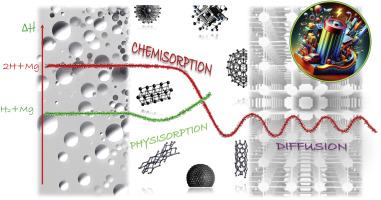Review of computational advances in tailoring magnesium-hydrogen interactions: Atomistic simulations meet machine learning
IF 8.3
2区 工程技术
Q1 CHEMISTRY, PHYSICAL
引用次数: 0
Abstract
The interaction between hydrogen and magnesium holds significant importance across various applications such as hydrogen storage, tunable optical devices and energy conversion technologies. This review provides an in-depth analysis of the intricate interactions between magnesium and hydrogen, highlighting pivotal findings from atomistic simulations and recent integration of machine learning techniques. The focus is twofold: firstly, to distill the essence of what atomistic simulations have revealed about magnesium-hydrogen interactions, covering properties of magnesium-based hydrides and thermodynamic and kinetics of physisorption, dissociation, adsorption, desorption, diffusion and phase transitions. The review focuses on materials enhancement through doping, alloying, and nanostructuring by emphasizing insights gained by density functional theory and molecular dynamics. Secondly, we examine the transformative role of machine learning in advancing our understanding and predictive capabilities within this domain.

镁-氢相互作用定制计算进展回顾:原子模拟与机器学习
氢与镁之间的相互作用在储氢、可调谐光学器件和能源转换技术等各种应用中具有重要意义。本综述深入分析了镁与氢之间错综复杂的相互作用,重点介绍了原子模拟和最近机器学习技术整合的重要发现。重点有两个方面:首先,提炼原子模拟揭示的镁氢相互作用的本质,涵盖镁基氢化物的特性以及物理吸附、解离、吸附、解吸、扩散和相变的热力学和动力学。综述侧重于通过掺杂、合金化和纳米结构增强材料的性能,强调密度泛函理论和分子动力学所获得的见解。其次,我们探讨了机器学习在促进我们对该领域的理解和预测能力方面所发挥的变革性作用。
本文章由计算机程序翻译,如有差异,请以英文原文为准。
求助全文
约1分钟内获得全文
求助全文
来源期刊

International Journal of Hydrogen Energy
工程技术-环境科学
CiteScore
13.50
自引率
25.00%
发文量
3502
审稿时长
60 days
期刊介绍:
The objective of the International Journal of Hydrogen Energy is to facilitate the exchange of new ideas, technological advancements, and research findings in the field of Hydrogen Energy among scientists and engineers worldwide. This journal showcases original research, both analytical and experimental, covering various aspects of Hydrogen Energy. These include production, storage, transmission, utilization, enabling technologies, environmental impact, economic considerations, and global perspectives on hydrogen and its carriers such as NH3, CH4, alcohols, etc.
The utilization aspect encompasses various methods such as thermochemical (combustion), photochemical, electrochemical (fuel cells), and nuclear conversion of hydrogen, hydrogen isotopes, and hydrogen carriers into thermal, mechanical, and electrical energies. The applications of these energies can be found in transportation (including aerospace), industrial, commercial, and residential sectors.
 求助内容:
求助内容: 应助结果提醒方式:
应助结果提醒方式:


